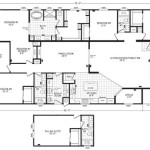Section 8 Housing: Understanding Two-Bedroom Options
Section 8 housing, formally known as the Housing Choice Voucher Program, is a federally funded initiative designed to assist low-income families, the elderly, and individuals with disabilities in affording decent, safe, and sanitary housing in the private market. This article focuses specifically on the availability and considerations surrounding two-bedroom units within the Section 8 housing program.
The Housing Choice Voucher Program operates by providing eligible participants with a voucher, which they can use to subsidize their rent. The voucher amount is determined by several factors, including the participant's income, family size, and the average cost of housing in the area. The participant then searches for housing in the private market that meets the program's requirements. Once a suitable unit is found and approved by the local Public Housing Agency (PHA), the participant pays a portion of the rent, and the PHA pays the remaining portion directly to the landlord.
Securing a two-bedroom unit under Section 8 can be a critical need for many families, particularly those with children or those requiring space for caregivers or accessibility equipment. Understanding the dynamics of the program concerning this specific type of housing is crucial for both prospective tenants and landlords.
Eligibility and Voucher Size for Two-Bedroom Units
The PHA determines the appropriate voucher size based on household composition. Generally, a two-bedroom unit is considered suitable for households of two to four individuals. While the specific criteria can vary slightly between different PHAs, the underlying principle remains consistent: the voucher size should correspond to the family’s needs, ensuring adequate space while preventing overcrowding.
To be eligible for Section 8, applicants must meet income requirements, which are established by HUD (the Department of Housing and Urban Development) and vary depending on the location. Income limits are typically expressed as a percentage of the area median income (AMI). In addition to income limits, applicants are subject to background checks and must meet other eligibility criteria, such as citizenship or legal residency requirements. Some PHAs may also prioritize certain applicant groups, such as veterans or families with children.
The total amount of the voucher is not fixed and is dependent upon the specific unit chosen and the rent requested by the landlord. The PHA will conduct a rent reasonableness test to ensure that the requested rent is comparable to other similar units in the area. This test aims to prevent landlords from charging inflated rents simply because the tenant is receiving a subsidy. If the rent is deemed reasonable and the unit meets HUD’s Housing Quality Standards (HQS), the PHA will approve the unit for participation in the program and will commit to paying the landlord the agreed-upon portion of the rent each month.
Challenges in Finding Two-Bedroom Section 8 Housing
Despite the program’s intent to provide affordable housing options, finding suitable two-bedroom units under Section 8 can be challenging. One of the primary obstacles is the limited availability of affordable housing in general, which is further compounded by the scarcity of landlords willing to participate in the program. Landlord participation rates are influenced by factors such as administrative complexities, perceived stigma associated with Section 8 tenants, and concerns about bureaucratic oversight.
Another challenge is the competition for available units. In many areas, the demand for Section 8 housing far exceeds the supply, resulting in long waiting lists and intense competition for available units. This can make it difficult for families with vouchers to find suitable housing within the timeframe allowed by the PHA, which can lead to the voucher expiring and the applicant having to reapply.
Furthermore, certain neighborhoods may have a higher concentration of Section 8 housing than others, which can contribute to issues of segregation and unequal access to opportunities. While the Housing Choice Voucher Program is intended to promote housing choice and deconcentrate poverty, its effectiveness in achieving these goals is often limited by the availability of housing in diverse neighborhoods.
Navigating the Section 8 Application and Housing Search Process
The process of applying for and securing Section 8 housing can be complex and time-consuming. It typically begins with submitting an application to the local PHA. The PHA will then review the application to determine eligibility and, if eligible, will place the applicant on a waiting list. The waiting list can be extensive, and applicants may have to wait months or even years before a voucher becomes available.
Once a voucher is issued, the applicant is responsible for finding a suitable unit that meets the program’s requirements. This involves searching for apartments or houses in the private market and contacting landlords to inquire about their willingness to accept Section 8 vouchers. It is essential to communicate clearly and professionally with landlords and to provide all necessary documentation promptly.
After finding a potential unit, the applicant must request that the PHA inspect the unit to ensure that it meets Housing Quality Standards (HQS). HQS cover a wide range of factors, including safety, sanitation, and structural integrity. If the unit passes the inspection, the PHA will then negotiate a lease agreement with the landlord and the tenant. The lease agreement will specify the rent amount, the responsibilities of the landlord and tenant, and other important terms and conditions.
Throughout the process, it is crucial to maintain open communication with the PHA and to seek assistance when needed. The PHA can provide guidance on the application process, help with the housing search, and assist with resolving any issues that may arise.
Several resources are available to assist individuals and families navigating the Section 8 housing program. HUD provides information and resources on its website, including a directory of local PHAs. Additionally, many non-profit organizations offer housing counseling and assistance to low-income individuals and families. These organizations can provide guidance on the application process, help with the housing search, and assist with resolving landlord-tenant disputes.
Successfully securing a two-bedroom unit under Section 8 requires persistence, patience, and a thorough understanding of the program's requirements and procedures. While the challenges can be significant, the program offers a vital lifeline to low-income families, providing access to safe and affordable housing that would otherwise be unattainable.

Section 8 Approved Updated 2bed 1bath In House Rental St Louis Mo Forrent Com

Brookview Townhomes Section 8 Housing 1600 W Seminary St Richland Center Wi Zillow

Section 8 Housing Nc 211

Section 8 Rental Properties In Saint Louis Mo Affordablehousing Com

2 Bedroom Section 8 Rental Properties In Cincinnati Oh Affordablehousing Com

Section 8 Rental Properties In San Antonio Tx Affordablehousing Com

2 Bedroom Section 8 Rental Properties In Howard County Md Affordablehousing Com

Affordable Housing Montaje

Section 8 Rental Properties In Cincinnati Oh Affordablehousing Com

2 Bedroom Section 8 Apartments For Rent In Hempstead Ny Affordablehousing Com








